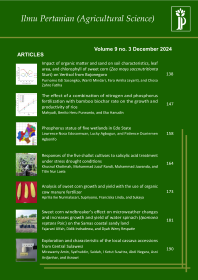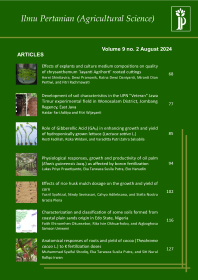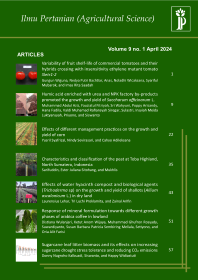Growth and Yield of Shallot (Allium cepa L. Aggregatum group) with Application of Beneficial Microorganisms
Taufiq Hidayat(1*), Prapto Yudono(2), Endang Sulistyaningsih(3), Arif Wibowo(4)
(1) Faculty of Agriculture Universitas Muhammadiyah Yogyakarta
(2) Faculty of Agriculture Universitas Gadjah Mada, Yogyakarta
(3) Faculty of Agriculture Universitas Gadjah Mada, Yogyakarta
(4) Faculty of Agriculture Universitas Gadjah Mada, Yogyakarta
(*) Corresponding Author
Abstract
Shallot (Allium cepa L. Aggregatum group) is one of the most widely utilized vegetables by Indonesian people. Some technologies have been adapted to improved shallot productivity. One of those are the application of beneficial microorganisms. We applied mycorrhizal fungi, Trichoderma sp., and Bacillus thuringiensis as well as the combination among these microorganisms were applied in Shallots cultivation and were investigated to improve the growth and development of shallot. A field experiment was arranged in a Randomized Complete Block Design with two treatment factors. The first factor consisted of two shallot cultivars, namely Biru Lancor and Crok Kuning; whilst the second factor consisted of six beneficial microorganism treatments, i.e. control, mycorrhizae, Trichoderma sp., Bacillus thuringiensis, the combination of mycorrhizae and Trichoderma sp., and the combination of those three microorganisms. The observation was conducted on infection percentage of mycorrhizae, total population of Trichoderma sp., leaf area, leaf area index, net assimilation rate, crop growth rate, harvest index, and plant yield. The data obtained were subjected to analysis of variance (ANOVA) and continued with Duncan’s Multiple Range Test (DMRT) at 5% significance level. The results showed the leaf area of shallot was improved as affected by the application of mycorrhizal fungi. The effectiveness and implication of mycorrhizal fungi on shallot growth would decrease if the application of was combined with other microorganisms. However, the application of beneficial microorganisms had not been able to increase component yield and yield of Biru Lancor and Crok Kuning, indicated by bulb weight, number of bulb, bulb diameter, number of bulb per cluster, and bulb yield per hectare.
Keywords
Full Text:
PDFReferences
Akhwan, I.A.S., E. Sulistyaningsih. & J. Widada. 2012. Peran JMA dan Bakteri Penghasil ACC Deaminase terhadap Pertumbuhan dan Hasil Bawang Merah pada Cekaman Salinitas. Vegetalika, (1) 2:139-152.
Anonymous. 2016a. Deskripsi Bawang Merah Varietas Crok Kuning. http://varitas.net/dbvarietas/deskripsi/4110.pdf. (Accessed 10 Oktober 2016).
Anonymous. 2016b. Deskripsi Bawang Merah Varietas Biru Lancor. http://varitas.net/dbvarietas/deskripsi/2024.pdf. (Accesed 10 Oktober 2016).
Bolandnazar, S., M.R. Neyshabouri, N. Aliasgharzad & N. Chaperzadeh. 2007. Effect of Mycorrhizal Colonization on Growth Parameter on Onion Under Irrigation and Soil Condition. Pakistan Journal Biological Science, 9:1491-1495
Brundrett, M.C. 2004. Diversity and Classification of Mycorrhizal Associations. Biological Reviews, 78: 473-495.
Chattopadhyay A., N.B. Bhatnagar, & R. Bhatnagar. 2004. Bacterial insecticidal toxins. Critical Reviews in Microbioliogy, 30: 33-54.
Darsan, S., E. Sulistyaningsih, & A. Wibowo. 2016. Various Shallot Seed Treatments with Trichoderma to Increase Growth and Yield on Sandy Coastal. Ilmu Pertanian, 1(3):94-99.
Debire, T.G., S. Bonzi, I. Somda & A. Legreve. 2016. Evaluation of The Potential of Trichoderma harzianum as a Plant Growth Promoter and Biological Control Againts Fusarium Damping off in Onion in Burkina Faso. Asian Journal of Plant Pathology, 10: 49-60.
Deressa, T.G. & Schenk, K.M. 2008. Contribution of Roots and Hyphae to Phosphorus Uptake of Mycorrhizal Onion (Allium cepa L.)-A Mechanistic Modeling Approach. Journal Plant Nutrient and Soil Science, 171:810-820.
Direktorat Jenderal Hortikultura. 2016. Hasil Pencarian Berdasarkan Indikator: Bawang Merah. https://aplikasi.pertanian.go.id/bdsp/hasil_ind.asp. (accessed 10 Octobers 2016).
Fracchia, S., A. Aranda-Rickert, E. Flashland, G. Terada, & S. Sede. 2004. Mycorrhizal Compatability and Symbiotic Reproduction of Gavilea australis, an Endangered Terrestrial Orchid from South Patagonia. Mycorrhiza, 28(4): 627-634.
Harman, G. E. 2000. Myths and Dogmas of Biocontrol. Plant Disease, 84:377-393.
Karanova, M., F.A. Lattanzi, A.A. Grimoldi & H. Schnyder. Phosphorus Defficiency Decreases Cell Division and Elongation in Grass Leaves. Plant Physiology, 141(2): 766-775.
Klein, D. & E. Eveleigh. 1998. Ecology of Trichoderma. In Harman, G.E. and C.P. Kubicek. Trichoderma and Gliocladium Vol. 1 Basic Biology, Taxonomy and Genetics. Taylor and Francis Ltd. London. 278p.
Lorito M, Woo LS, Harman GE, & Monte E (2010) Translational research on Trichoderma: from’omics to the field. Annual Review of Phytopathology, 48:395–417.
McGonigle, T.P., M.H. Miller, D.G. Evans, G.L. Fairchild, & J.A. Swan. 1990. A New Method Which Gives an Objective Measure of Colonisation of Roots by Vesicular-Arbuscular Mycorrhizal Fungi. A New Pathologist, 115 (3) 495-501.
Pangestuti, R. & E. Sulistyaningsih. 2011. Potensi Penggunaan True Seed Shallot (TSS). Sebagai Sumber Benih Bawang Merah di Indonesia. Prosiding Smiloka Nasional: Dukungan Agro-Inovasi untuk Pemberdayaan Petani Kerjasama UNDIP, BPTP Jateng, dan Pemrov Hateng. 258-266.
Qi, J., D. Aiuchi, M. Tani, S. Asano, & M. Koike. 2016. Potential of Entomopathogenic Bacillus thuringiensis as Plant Growth Promoting Rhiobacteria and Biologicl Control Agents for Tomato Fusarium Wilt. International Journal of Environmental and Agriculture Research, 2 (6):55-63.
Sakinah, F. 2013. Analisis Pengaruh Faktor Cuaca Untuk Prediksi Serangan Organisme Pengganggu Tanaman (OPT) pada Tanaman Bawang Merah. (skripsi) Bogor: Institut Pertanian Bogor.
Shuab, R., R. Lone, J. Naidu, V. Sharma, S. Imtiyaz & K.K. Koul. 2014. Benefits of Inoculation of Arbuscular Mycorrhizal Fungi on Growth and Development of Onion (Allium cepa) Plant. American-Eurasian Journal of Agriculture & Environmental Science, 14 (6): 527-535.
Smith, S.E., I. Jakobsen, M. Gronlund, & F.A. Smith. 2011. Roles of Arbuscular Mycorrhizas in Plant Phosphorus Nutrition: Interaction Between Pathways of Phosphorus Uptake in Arbuscular Mycorrhizal Roots Have Important Implication for Understanding and Manipulating Plant Phosphorus Acquisition. Plant Physiology, 156:1050-1057.
Sulistyaningsih, E., K. Yamashita & Y. Tashiro. 2002. Haploid Induction from F1 Hybrid between CMS Shallot with Allium galanthum Cytoplasm and Common Onion by Unpollinated Flower Culture. Euphytica, 125:139-144.
Sumiati, E. & O.S. Gunawan. 2006. Aplikasi pupuk hayati Mikoriza untuk meningkatkan efisiensi serapan unsur hara NPK serta pengaruhnya terhadap hasil dan kualitas umbi bawang merah. Jurnal Hortikultura, 17(1):34-42.
Suryani, R., S. Gafur & T. Abdurrahman. 2017. Respon Tanaman Bawang Merah Terhadap Cendawan Mikoriza Arbuskula (CMA) pada Cekaman Kekeringan di Tanah Gambut. Jurnal Pedon Tropika, 1(3):69-78.
Tuhuteru, S., E. Sulistyaningsih, & A. Wibowo. 2016. Effects on Plant Growth Promoting Rhizobacteria (PGPR) on Growth and Yield of Shallot in Sandy Coastal Land. Ilmu Pertanian, 1(3):105-110.
Viterbo A, U. Landau, S. Kim, L. Chernin, & I. Chet. 2010. Characterization of ACC deaminase from the biocontrol and plant growth-promoting agent Trichoderma asperellum T203. FEMS Microbiology Lettets, 305: 42–8.
Wilson M.K., R.J. Abergel, K.N. Raymond, J.E.L. Arceneaux, & B.R. Byers. 2006. Siderophores of Bacillus anthracis, Bacillus cereus and Bacillus thuringiensis. Biochemical and Biophysical Research Communications, 348: 320-325.
Article Metrics
Refbacks
- There are currently no refbacks.
Ilmu Pertanian (Agricultural Science) ISSN 0126-4214 (print), ISSN 2527-7162 (online) is published by Faculty of Agriculture Universitas Gadjah Mada collaboration with Perhimpunan Sarjana Pertanian Indonesia (PISPI) and licensed under a Creative Commons Attribution-ShareAlike 4.0 International License.














